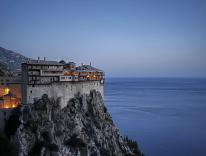The day of Pope Francis’s death, a text from an Irish cousin in County Donegal arrived: “John, don’t you know, Noreen’s cousin is the monsignor in charge of the pope’s burial!” The text reminded me that the wife of my first cousin Paul Fegan grew up in the village of Downings with Monsignor Eamonn McLaughlin, who was a classmate of her brothers. During a birthday call to my Aunt Kathleen last week—she turned ninety a day before the pope’s funeral and burial—she excitedly told me that the monsignor had been in her home just weeks ago when he was back in Downings for a visit.
I wasn’t aware of the “family connection” until I heard a report that the pope had decided to be buried at the Papal Basilica of Saint Mary Major (Basilica di Santa Maria Maggiore). That’s where Monsignor McLaughlin serves in Rome as a canon. (Before moving to the Vatican, he had served at St. Eunan’s Cathedral in nearby Letterkenny.)
Until then, I had no idea that the Msgr. McLaughlin would be tasked with overseeing the preparations for Francis’s burial, which required close cooperation with other Vatican officials to ensure that the rites aligned with both the pope’s wishes and the Church’s traditions. Francis is only the fourth pope to be buried and Saint Mary Major and the first in four centuries (the last was Pope Clement IX in 1669). Most pontiffs have followed papal tradition and requested burial at St. Peter’s Basilica. Apart from Francis, there have been only three exceptions to this tradition in the past five hundred years: Leo XIII (d. 1903), who was buried at the Basilica of St. John Lateran; Pius IX (d. 1878), whose tomb can be found at the Basilica of San Lorenzo fuori le Mura (St. Lawrence Outside the Walls); and Clement XIV (d. 1774), who was buried at Santi Apostoli Basilica.
Msgr. McLaughlin, whose official title is “Undersecretary for the Dicastery for Clergy, Seminary Section,” is the Vatican official responsible for seminaries and priestly formation. He was appointed to this position by Pope Francis in April 2024. His involvement in the pope’s burial was widely reported in County Donegal—and indeed throughout Ireland. Because Francis chose a special burial site, McLaughlin wasn’t just helping bury a pope; he was also creating a new precedent for papal burial, one rooted in the Francis’s well-known Marian devotion. In interviews, both McLaughlin and his fellow Irish clerics noted how important Saint Mary Major was to Francis personally. On the very first morning after his election as pope (March 14, 2013), Francis immediately went not to St. Peter’s but to St. Mary Major. There he prayed silently at the icon of Salus Populi Romani (“Protector of the Roman People), an ancient image of the Virgin Mary believed to have miraculously saved Rome from plague and other disasters. Throughout his pontificate, before and after every major international trip, Francis visited St. Mary Major—always stopping to pray before that icon. As a result, the basilica became his “spiritual home base.” Francis often said that Mary’s protection over his ministry was vital, and that he entrusted his whole papacy to her. He visited the basilica more than a hundred times during his twelve-year papacy.
McLaughlin remarked that Pope Francis’s choice of Saint Mary Major for his burial represented his final, humble act of devotion to Mary. In his instructions for burial at Saint Mary Major, he specified that his tomb should be “in the ground; simple, without particular ornamentation, bearing only the inscription: Franciscus.” A few months before Msgr. McLaughlin became canon, Francis had also considerably simplified the traditional rites, joking that he would “premiere the new ritual” at his own funeral.
McLaughlin’s personal relationship with Francis dates back to October 2022, when they first worked together in the aftermath of a tragic oil explosion in Creeslough, a tiny village in Donegal. The accident claimed ten lives, including three children, and left a dozen injured. Creeslough (pronounced KREE-sluh), the birthplace of my maternal grandmother, has fewer than four hundred residents, so about two-thirds of the families in the village were directly affected. (Just hours earlier, one of my aunts had been at the site of the blast, the village’s Applegreen petrol station.) The disaster was headline news not only in Ireland but throughout the United Kingdom and much of the European Union.
Throughout that calamitous week, the monsignor—who had just been transferred to Rome a few months earlier to assist in clergy formation—served as a direct liaison between Ireland and Francis, conveying daily messages from the pope to the village. On October 8, the day after the explosion, Francis issued a message to Ireland, expressing his “spiritual closeness to all those suffering in the aftermath of this tragedy” and imploring “the divine blessings of consolation and healing upon the injured, the displaced, and the families coping with pain of loss.” Beyond this written message, Pope Francis delegated Msgr. McLaughlin to personally deliver individual sets of black-and-white rosary beads, each in a pouch embossed with the papal emblem, to the families of the deceased. Both the pope’s sensitivity and the monsignor’s pastoral care were appreciated immensely by my family clan.
After Francis’s death, another cousin and I reflected on how the pope’s compassion that fateful week for villagers in a remote Irish hamlet dovetailed with his choosing Saint Mary Major as his final resting place. His tenderness and humility—a word that keeps cropping up in so many personal accounts of Francis—in the midst of Creeslough’s misfortune reflected “the gentle and maternal care [of] the Immaculate Mother,” a phrase from the pope’s last testament. He died as he had lived, modeling the simplicity and brotherhood that he believed to be the heart of the Christian life.
